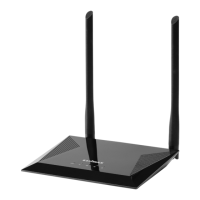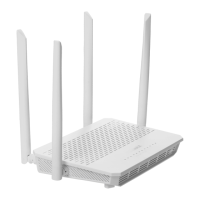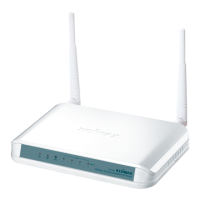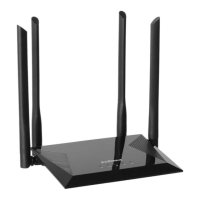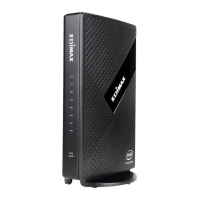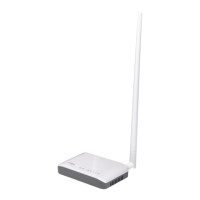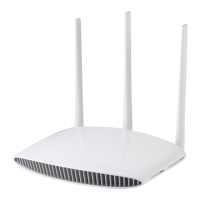Do you have a question about the Edimax BR-6428nS V3 and is the answer not in the manual?
Lists the items included in the product package, such as the router, power adapter, cables, etc.
Explains the meaning of different LED indicators on the device (Power, Internet, Wi-Fi, WPS).
Identifies and labels the physical ports and buttons on the back of the device.
Provides crucial safety instructions for using the device, covering electrical safety and handling.
Detailed guide on how to set up the device as a Wi-Fi router.
Instructions for configuring the device to function as an Access Point.
Steps to set up the device to extend the range of an existing Wi-Fi network.
Guide for setting up the device in Wireless Bridge mode to connect wired devices to Wi-Fi.
Instructions for configuring the device to connect to a WISP (Wireless Internet Service Provider).
How to use Wi-Fi Protected Setup (WPS) to easily connect devices.
Procedures for resetting the device to its original factory settings.
Steps to access and log into the device's web-based configuration interface.
Explains how to save configuration changes and restart the device.
Overview of the main menu options available depending on the device's operating mode.
Displays basic system information about the device, categorized into System, LAN, Internet, and 2.4GHz Wireless.
How to use the setup wizard to reconfigure basic settings or switch operating modes.
Accesses WAN and DDNS settings; shows WISP mode specific interface.
Configure Wide Area Network (WAN) connection modes and settings based on ISP.
Steps for setting up an automatic IP address configuration using DHCP.
Instructions for configuring a fixed IP address provided by the ISP.
Configuration for PPPoE (Point-to-Point Protocol over Ethernet) internet connection type.
Configuration for PPTP (Point-to-Point Tunneling Protocol) internet connection type.
Configuration for L2TP (Layer 2 Tunneling Protocol) internet connection type.
Configuration for connecting to a Wireless Internet Service Provider (WISP).
Setup for Dynamic DNS service to map dynamic IP addresses to a fixed hostname.
Configure Local Area Network (LAN) settings, including IP address and DHCP server.
Configure SSID, security, and other settings for the primary 2.4GHz Wi-Fi network.
Basic settings for the primary 2.4GHz Wi-Fi network, including SSID and mode.
How to disable the wireless function and security settings.
Configuration for WEP encryption, a basic security type.
Recommended and secure WPA Pre-Shared Key encryption settings.
Configuration for WPA encryption with RADIUS user authentication.
Setting up a guest Wi-Fi network or multiple SSIDs for guest access.
How to use Wi-Fi Protected Setup (WPS) for easy device connection.
Configure MAC filtering to control network access and prevent unauthorized users.
Automate wireless radio on/off scheduling at specified times.
Configure URL blocking, access control, DMZ, and DoS functions for network security.
Block internet access by specific URLs or keywords.
Configure MAC and IP filtering to control network access and prevent unauthorized users.
Set up a virtual DMZ host for unrestricted two-way access to specific private IP addresses.
Configure Denial-of-Service (DoS) protection to prevent network attacks.
Manage Internet bandwidth efficiently to ensure sufficient bandwidth for applications.
Enable/disable QoS function and set up QoS rules for bandwidth management.
Use iQoS for intuitive, automated bandwidth management and network application prioritization.
Access advanced features of the device, including routing and network configurations.
Configure static routing to define path selection of routers in the network.
Redirect ports of an Internet IP address to a local IP address for specific applications.
Set up internet services on local computers and redirect ports via a single internet IP.
Advanced settings for the 2.4GHz wireless module for experienced users.
Configure IGMP snooping and proxy for efficient multicast group memberships and IPTV streaming.
Enable Universal Plug and Play (UPnP) for network devices to communicate and configure automatically.
Access various administrative functions like time zone, password, and upgrades.
Set the device's time zone and configure NTP server for automatic time setup.
Change the login password for the browser-based configuration interface for security.
Enable and configure remote access to the device.
Save, restore, or reset device configuration settings.
Upgrade the device's system firmware to the latest version.
Restart the device if it malfunctions or becomes unresponsive.
View system and security logs for monitoring device activity.
Displays information about active DHCP clients connected to the network.
Shows sent and received packet network statistics.
Guide on setting up your computer's IP address for initial access and configuration.
Instructions to verify if the computer is set to obtain an IP address automatically.
Guide on how to manually set a static IP address for computer configuration.
Instructions for finding the Wi-Fi network security key (password).
Instructions for locating the router's IP address on different operating systems.
Guide on how to connect to the device's Wi-Fi network (SSID).
Common problems and solutions for using the device, including Wi-Fi connection issues.
Definitions of technical terms used in the manual, such as IP Address, DHCP, and WAN.
Lists the items included in the product package, such as the router, power adapter, cables, etc.
Explains the meaning of different LED indicators on the device (Power, Internet, Wi-Fi, WPS).
Identifies and labels the physical ports and buttons on the back of the device.
Provides crucial safety instructions for using the device, covering electrical safety and handling.
Detailed guide on how to set up the device as a Wi-Fi router.
Instructions for configuring the device to function as an Access Point.
Steps to set up the device to extend the range of an existing Wi-Fi network.
Guide for setting up the device in Wireless Bridge mode to connect wired devices to Wi-Fi.
Instructions for configuring the device to connect to a WISP (Wireless Internet Service Provider).
How to use Wi-Fi Protected Setup (WPS) to easily connect devices.
Procedures for resetting the device to its original factory settings.
Steps to access and log into the device's web-based configuration interface.
Explains how to save configuration changes and restart the device.
Overview of the main menu options available depending on the device's operating mode.
Displays basic system information about the device, categorized into System, LAN, Internet, and 2.4GHz Wireless.
How to use the setup wizard to reconfigure basic settings or switch operating modes.
Accesses WAN and DDNS settings; shows WISP mode specific interface.
Configure Wide Area Network (WAN) connection modes and settings based on ISP.
Steps for setting up an automatic IP address configuration using DHCP.
Instructions for configuring a fixed IP address provided by the ISP.
Configuration for PPPoE (Point-to-Point Protocol over Ethernet) internet connection type.
Configuration for PPTP (Point-to-Point Tunneling Protocol) internet connection type.
Configuration for L2TP (Layer 2 Tunneling Protocol) internet connection type.
Configuration for connecting to a Wireless Internet Service Provider (WISP).
Setup for Dynamic DNS service to map dynamic IP addresses to a fixed hostname.
Configure Local Area Network (LAN) settings, including IP address and DHCP server.
Configure SSID, security, and other settings for the primary 2.4GHz Wi-Fi network.
Basic settings for the primary 2.4GHz Wi-Fi network, including SSID and mode.
How to disable the wireless function and security settings.
Configuration for WEP encryption, a basic security type.
Recommended and secure WPA Pre-Shared Key encryption settings.
Configuration for WPA encryption with RADIUS user authentication.
Setting up a guest Wi-Fi network or multiple SSIDs for guest access.
How to use Wi-Fi Protected Setup (WPS) for easy device connection.
Configure MAC filtering to control network access and prevent unauthorized users.
Automate wireless radio on/off scheduling at specified times.
Configure URL blocking, access control, DMZ, and DoS functions for network security.
Block internet access by specific URLs or keywords.
Configure MAC and IP filtering to control network access and prevent unauthorized users.
Set up a virtual DMZ host for unrestricted two-way access to specific private IP addresses.
Configure Denial-of-Service (DoS) protection to prevent network attacks.
Manage Internet bandwidth efficiently to ensure sufficient bandwidth for applications.
Enable/disable QoS function and set up QoS rules for bandwidth management.
Use iQoS for intuitive, automated bandwidth management and network application prioritization.
Access advanced features of the device, including routing and network configurations.
Configure static routing to define path selection of routers in the network.
Redirect ports of an Internet IP address to a local IP address for specific applications.
Set up internet services on local computers and redirect ports via a single internet IP.
Advanced settings for the 2.4GHz wireless module for experienced users.
Configure IGMP snooping and proxy for efficient multicast group memberships and IPTV streaming.
Enable Universal Plug and Play (UPnP) for network devices to communicate and configure automatically.
Access various administrative functions like time zone, password, and upgrades.
Set the device's time zone and configure NTP server for automatic time setup.
Change the login password for the browser-based configuration interface for security.
Enable and configure remote access to the device.
Save, restore, or reset device configuration settings.
Upgrade the device's system firmware to the latest version.
Restart the device if it malfunctions or becomes unresponsive.
View system and security logs for monitoring device activity.
Displays information about active DHCP clients connected to the network.
Shows sent and received packet network statistics.
Guide on setting up your computer's IP address for initial access and configuration.
Instructions to verify if the computer is set to obtain an IP address automatically.
Guide on how to manually set a static IP address for computer configuration.
Instructions for finding the Wi-Fi network security key (password).
Instructions for locating the router's IP address on different operating systems.
Guide on how to connect to the device's Wi-Fi network (SSID).
Common problems and solutions for using the device, including Wi-Fi connection issues.
Definitions of technical terms used in the manual, such as IP Address, DHCP, and WAN.
| Ethernet LAN | Yes |
|---|---|
| Cabling technology | 10/100Base-T(X) |
| Networking standards | IEEE 802.11b, IEEE 802.11g, IEEE 802.11n |
| Ethernet LAN data rates | 10, 100 Mbit/s |
| Ethernet LAN interface type | Fast Ethernet |
| Wi-Fi band | No |
| Wi-Fi standards | 802.11b, 802.11g, Wi-Fi 4 (802.11n) |
| Top Wi-Fi standard | Wi-Fi 4 (802.11n) |
| Input current | 1 A |
| Rack mounting | - |
| Supported protocols | PPPoE, static IP, dynamic IP, PPTP & L2TP |
| WLAN data transfer rates supported | 11, 54, 300 Mbit/s |
| Ethernet LAN (RJ-45) ports | 4 |
| Security algorithms | 128-bit WEP, 64-bit WEP, WPA-PSK, WPA2-PSK |
| Antennas quantity | 2 |
| Antenna gain level (max) | 5 dBi |
| Product color | White |
| LED indicators | Activity, LAN, Link, Power, WAN |
| Flash memory | 4 MB |
| Certification | CE, FCC, NCC, BSMI |
| Internal memory | 32 MB |
| Operating temperature (T-T) | 0 - 40 °C |
| Operating relative humidity (H-H) | 10 - 90 % |
| Cables included | LAN (RJ-45) |
| Output voltage | 5 V |
| Depth | 162 mm |
|---|---|
| Width | 190 mm |
| Height | 42 mm |
| Weight | 245 g |
